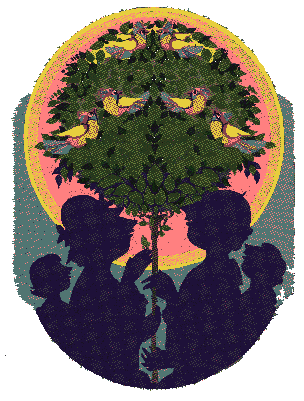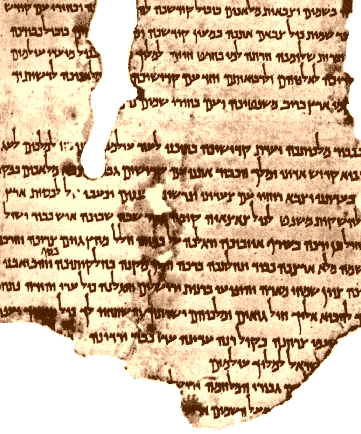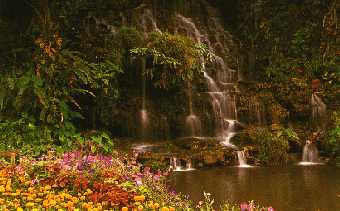The Dead Sea Scrolls
By a coincidense in 1947, a collection of Hebrew and Aramaic manuscripts where discovered in a series of caves in at the northwesteren end of the Dead Sea in the area of Khirbet Qumran. The seven principal scrolls were discovered by Bedoins. Initial discovery of the scrolls was followed by scientifix exploration of the neighboring caves under the auspices of the Department of Antiquities of Jordan, the Palestine Archeological Museum (now the Rockefeller Museum), and the Dominican Ècole Biblique et Archèologique of Jerusalem. The manuscripts, attributed to members of a previously unknown jewish brotherhood, originally written on papyrus or leather, number more than 600 in various states of preservation.
The qumran brotherhood is portrayted in the manuals of discipline as a kind model House of Israel, designed to prepar the way for the imminent comming of the kingdom of God and the day of jugdement: Details of a final battle between the "sons of light" and the "sons of darkness".
 The Angel of Water
The Angel of Water
From the Heavenly Sea
the Waters run and flow forward
from the never-failing Springs.
To the dry and barren desert
have the Brothers brought the Angel of Water:
That She might bring forth a garden and a green place,
 tree-filled and fragnat with flowers.
tree-filled and fragnat with flowers.
Cast thyself into the enfolding arms
of the Angel of Water:
For She shall cast out from thee
all that is unclean and evil.
Let my love flow towards thee, my Heavenly Father,
as the gentle rain doth kiss the Earth.
As a River through the forest
is the Holy Law.
All creatures depend on it,
and it denieth nothing to any being.
The Law is to the world of men
what a great River is to streams and brooks.
As Rivers of Water in a dry place
are the Brothers who bringeth the Holy Law
to the world of men.
In Water mayest thou quent thy thirst.
Thus is the Holy Law a two-eged sword:
By the Law mayest thou destroy thyself,
and by the Law mayest thou see God.
The Dead Sea scrolls are of significance for Biblical Sholars. Paleographic evidence indicates that most of the documents were written at various dates between approximately 200 BC and AD 68. Archeological evidence supports the latter date, for excavations at the site that it was sacked in the year AD 68, while an army under command of the Roman general Vespasian may have plundered the Essens community while en route to supress a Jewish rebellion begun in AD 66. However the documents presumably where hidden at some time between AD 66 and 68.
The many links between the trought and idom of the scrolls and of the New Testament are of special interest. Both emphasize the imminece of the kingdom of God. Similar charecterization are found of the faithful as "the elect" and the "children of light". The parralells are the more aressting because the the Qumran brotherhodd lived at the same time and in the same area as John the Baptist - whose ideas where subsequently reflected in the teaching by Jesus of Nazareth. As the Dead Sea scrolls were discovered, the manuscripts were put under control of the Israeli Antiques Authority by the government of Israel. The majority of the material is in tiny, brittle fragmets, and the pace of publication has been exeedingly slow. However in September 1991, scholars at Hebrew Union College in Cincinnati, Ohio, announced that they had used a published concordanse to create a computer-generated text of one of the unreleased schrolls. A number of translation of the manuscripts and commentaries on them have been written since their discovery.
Heavenly Father!
 From the Heavenly Sea flow all the Waters
From the Heavenly Sea flow all the Waters
that spread over all the seven Kingdoms.
This Heavenly Sea of thine alone
goeth on bringing Waters
both in summer and winter and in all seasons.
This Sea of thine purifieth the seed in males,
the womb in females,
the milk in female`s breasts.
Thy Heavenly Sea floweth down unrestrained
unto the big-seeded corn fields,
and utno the small-seeded pastuere fields,
and unto the whole of the Earhly World.
A thousand pure Springs run toward the pastures
that give food to the children of Light.
If any one shall sacrifice unto thee,
O thou holy Angel of Water!
To that one dost thou give both splendor and glory,
with health an with vigor of the body.
To him dost thou give a longer enduring life,
and the Heavenly Sea, thereafter.
We worship all the Holy Waters
which do quench the thirst on the Earth,
wheter standing, or running, or Wathers of the Well.
Or Spring-Waters which perennially flow,
 or the blessed drippings of the Rains,
or the blessed drippings of the Rains,
we do sacrifice unto the good and Holy Waters
which the Law hath created.
Let the Sea roar, and all the Waters,
the world and they that dwell therein.
Let the Floods clap their hans,
let the hills be joyful togheter.
The voice of the Lord is upon the Waters:
The God of Glory thundereth.
Heavenly Father! and thou, Angel of Water!
We are thankful to thee, an we bless thy name.
A flood of Love welleth up
from the hidden places beneath the Earth:
The Brotherhood is blessed forever
In the Holy Water of Life.
The Qumran Brotherhood was constituted in imitation of the organization of Israel under Moses. Study of the Law, the first section of the Hebrew Bible, was obligatory, and it was claimed that the correct interpretation of it had been handed down by a series of spiritual monitors, known as "correct expositors", or "teachers of righteousness". The era in whith the brotherhood lived was expected to end with the appearance of a new expositor and prophet:
"I will rice up for them a prophet, like you from among their brethren; and I will put my words in his mounth, and he shall speak to them all that I command him."
Deuteronomy 18:18
The scrolls include manuals of discipline, hymnbooks, biblical commentaries and apocalyptic writings. Two of the oldes known copies of the Book of Isaiah, almost wholy intact, and fragments of every book in the Old Testament exept that of Ester. Among the latte is a fanciful paraphrase of the Book of Genesis. Also found in the caves were text, in the original languages of several books of the Apocryphe and Pseudepigrapha. However these text, none of wich was included in the Hebrew canon of the Bible, are Jubilees Sirach, Tobit, portions of Enoch, and the Testament of Levi, hitherto known only in early Greek, Latin, Syriac and Ethiopic versions.
Can the scrolls answer life`s mysteries?
The fact that the scrolls survived for about two tousand years, that they were found accidentally by young Bedouin sheperds, searching for a stray goat in the Judean Desert, entered a long-untouched cave and found jars filled with ancient scrolls. Historical, paleographic, and linguistic evidence, as well as carbon 14-dating, established that the scrolls and the Qumran ruin dated from the third century B.C. to 68 A.D. It is a fact that they are the largest and oldest discovery relating to the Bible and to the time of Jesus of Nazareth make the Dead Sea Scrolls a truly remarkable archaeologigcal find. Unquestionable the scrolls fragmegts is the greatest manucript find of the twentieth century. Coming from the late Second Temple Period, a time when Jesus of Nazareth lived, they are older than any older surviving biblical manuscripts by almost one thousand years. Does the "War Rule Scroll" refer to a pierced or piercing
Messiah?
The Dead Sea Scrolls, wich date back to the events described in the New Testament, have added understanding of the Jewish background of Christianity. The scrolls have revolutinezed scholarship of the Second Temple period and trown new light on the origins of Christianyty, indicating that Jesus of Nazareth may have been an Essense, or at least was strongly influenced by the sect. The scrolls have revelated the mood of Messianic fatalism among the Jews of that time, explaining both the emergence of Christianity and the fervor of the Jewish rebels in their war agains Rome.
Scroll Fragments from the Qumran Library
Psalms Tehillim
Phylactery Tefillin
The Community Rule Serkeh ha-Yahad
Calendrical Document Mishmarot
Some Torah Precepts Miqsat Ma`ase ha-Torah
Enoch Hanokh
Hosea Commentary Pesher Hoshe`a
Prayer for King Jonathan Tefillah li-Shlomo shel Yonatan ha-Melekh
Leviticus Va-Yikrah
Songs of the Sabbath Sacrifice Shirot `Olat ha-Shabbat
Damascus Document Brit Damesek
The War Rule Serekh ha-Milhamah
The Dead Sea
The Dead Sea is located east of Jerusalem., situated some 400 meters below the sea level. The Dead Sea is the lowest point on the face of the globe, it is extremely deep, and some parts containing the highest amount of salts possible. Because of its low elevation and its position in a deep basin, the climate of the Dead Sea area is unusual. Its very high evaporation does produce a haze yet its atmospheric humidity is low. Adjacent areas to it are very arid and favorable for the preservation of material like the Dead Sea Scrolls.
However the Bible`s description (Genesis 19) of a destructive eartquake near the Dead Sea area during the time of
Abraham
is borne out by archeological and historic investigation. While no evedence remains of the five cities of the plain: Zeboim, Admah, Bela or Zoar, Sodom, and Gommorah, their sites are belived to be beneath the waters at the southern end of the sea. Archeological sites near the Dead Sea include Masada, Ein Gedi, and Qumran - where the Dead Sea Scrolls were found.
The Dead Sea Scrolls have been the subject of avid interest and curiosity for 49 years. Scholars agree on their significanse but disagree on who produced them. They debate specific passages of individual scrolls and are still assesing their impact on the foundations of Judaism and Christianity. Can the scrolls predict the future or answer life`s mysteries?
Visitors since February 19th, 1996:
)
STAVANGER HISTORY GUIDE - History, Humanity and Genuine Peace
BUDDHISM -Religion or Philosophy ?
Last modified: December 19, 1996